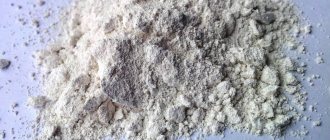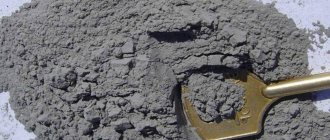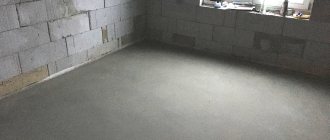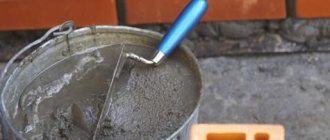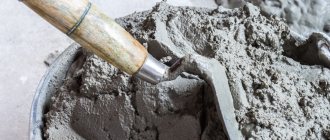The two most common grades of cement are M400 and M500. Photo Eurocement Group
Cement is an almost irreplaceable building material and is the main component of concrete mortars. Despite the wide variety of types, ordinary Portland cement of varying strengths is most often used in civil and industrial construction. According to strength there are several grades of cement , the most popular is M500.
What does the marking 42.5N, 42.5B mean in Russian, certificate of conformity
Marking of M500 cement is carried out in accordance with the requirements of GOST 2016. However, the 2003 standard has not been canceled, so it is possible to encounter markings that differ in appearance and contain different designations.
The new marking begins with an abbreviation of 3 Cyrillic letters - TsEM (or CEM - for foreign-made products) and Latin numbers, which allows you to determine the material composition of the product:
- CEM I - Portland cement without additives;
- CEM II - Portland cement with mineral additives, the proportion of which varies from 6 to 35%;
- CEM III - Portland slag cement with slag content from 36 to 65%;
- CEM IV - pozzolanic cement with an additive of volcanic origin;
- CEM V - composite cement may contain slag, ash, limestone.
The letters "A" and "B" show the amount of additives; A - 6-20% and B - 21-35%. Marking is used for all types except CEM I.
The letter “B” means the presence of limestone in the composition, “W” - slag.
The speed of strength development is designated by the letters “N” and “P”, normal and high early, respectively.
Cements from CEM II to CEM V can have subtypes in accordance with the type of additives . The subtypes are designated by the Latin letters “A”, “B” and “C”. After that there is a slash, followed by a letter indicating the type of additive, and after a dash a letter coding the additive. For example, TsEM N/A-I. If there are several additives in the composition, the designation is indicated through a dash, the entire group is taken in brackets - CEM IV/A (P-Z-Mk).
Cement with new sample markings. Photo SebryakovCement
Thus, part of the marking 42.5N is a normal-hardening cement (which type cannot be determined), capable of withstanding a pressure of 42.5 MPa; 42.5B is a fast-hardening cement (it is impossible to determine what type), capable of withstanding a pressure of 42.5 MPa.
On the packaging you may find old-style markings in which:
- type , depending on the type of main raw material used for the production of the binder, a distinction is made between Portland cement (PC) and slag Portland cement (SPC);
- brand , in this case M500, which indicates the material’s ability to withstand a load of 500 kg/sq.cm;
- the presence or absence of additional additives is indicated by the letter “D” and a number showing the percentage of additives, the most common brands are D0 and D20;
- the letter “B” indicates the presence of rapid hardening properties, and “N” indicates normal-hardening cement;
- “SS” - the binder is characterized by sulfate resistance;
- “PL” and “GF” are plasticized grades with increased frost resistance and hydrophobic with protection from significant exposure to moisture.
Cement with old-style markings. Photo by YuzhUralPBK
Regardless of the labeling on the packaging, it is recommended to choose products with certificates of conformity, safety protocols and other documents that can demonstrate the quality of the binder.
Other brands
The designation of other brands is carried out in a similar way. The only difference is the actual designation of the brands themselves, the compliance of which according to the old and new standards is as follows:
- grade B7.5 corresponds to M100;
- M200 -> B15.0;
- M300 -> B22.5;
- M400 -> B32.5;
- M500 -> B42.5;
- M600 -> B52.5;
- M700 -> B62.5.
Portland cement. Vimos Photos
It is possible to find both designations on product packaging; manufacturers use both old and new markings.
Manufacturers
The modern building materials market offers a fairly large selection of various mixtures and powders for various tasks. It is worth choosing products from trusted manufacturers who guarantee high quality components and their creation in accordance with technology.
"Monolith"
A large manufacturer that creates and sells cement-sand mixtures at a plant in Kirov. The range is quite large, it includes reliable and high-quality compositions of the M150 brand, well suited for plastering, sealing joints, and masonry indoors and outdoors.
We also sell reliable compositions of the M300 brand, which are relevant for the production of high-strength concrete structures.
Knauf
A well-known brand that supplies the market with high-quality cement and plaster mixtures in several lines (Sivener, Adhesive, Grünband, Unterputz). All products have excellent thermal insulation properties. Suitable for completing a full range of finishing works - interior/exterior. In most of the manufacturer’s mixtures, components are added to the composition to enhance positive properties.
"Real"
The manufacturer's products are popular and supply high-quality cement mixtures of the M75 and M150, M100 and M200 brands. The range allows you to choose what you need for finishing and repair work. Most dry mixes are supplemented with components to increase frost resistance, which expands the possibilities of working with them and allows them to be used both inside and outside.
Dauer
A German brand that offers inexpensive, high-quality DSP for finishing facades and walls indoors, pouring screeds, installing blocks and bricks.
The manufacturer's dry mixtures are very popular because they have low consumption and an affordable price, which, in general, can significantly reduce the cost of work.
"BaltPiterStroy"
A large Russian company supplying the market with cement-sand mortars of all brands. Also among the products you can find other components - rubble, gravel, crushed stone, sand, cement in bags and various reagents (anti-icing, for example).
"Stroyservis-Novablock"
Previously, the manufacturer’s cement-sand compositions were presented on the market under the Plita Milks brand. In addition to dry mixes, the product range includes a high-strength sand and gravel mixture of the M300 brand. All compositions are of very good quality, as they are produced on modern factory equipment on an industrial scale.
"Adamant SPB"
The plant offers a huge range of crushed stone, sand, cement, reinforced concrete products, and high-quality concrete. DSPs are represented by a variety of brands - the line includes both M100 and M400.
Composition and production
To produce cement, clinker, consisting of clay and limestone in certain proportions, is crushed and mixed with various additives that provide the necessary properties and scope of application:
- gypsum ensures expansion of the solution, making the material plastic;
- blast furnace or electrothermophosphorus slags are used as weighting mineral impurities;
- Plasticizers provide the necessary indicators of strength, moisture resistance, and frost resistance.
Depending on the type of cement, the composition may differ, but the production technology is almost the same in all cases.
M500 cement manufacturing technology
The raw materials for the production of Portland cement M500 are gypsum stone, clinker (a product of sintering clay and limestone), blast furnace charge, as well as plasticizing, acid-resistant and hydrophobic additives. For special types of material, some other components may be used. The technological process of cement production is divided into two enlarged stages, which in turn are divided into separate stages.
The first stage is the production of clinker, which is essentially the basis of a dry cement mixture. Clinker is obtained from a special mineral - brilliant green or yellowish-green limestone, which is mined from a depth of up to 10 m during the development of limestone deposits. Yellowish-green limestone is industrially pre-dried and then mixed with other components. After firing, the clinker is ready for subsequent technological operations.
At the second stage, the clinker is crushed to a powdery consistency with the addition of gypsum and special additives. The result is a loose, homogeneous mass. Depending on the quality and condition of the feedstock, it is possible to use one of three industrial methods for producing conditioned material: wet, dry or combined.
With the dry method, mixed raw materials are dried immediately before grinding or during the grinding process. After grinding the components into powder, the mixture is treated with burning gas. This method is now considered the most promising and economical in terms of energy consumption. The wet method involves preliminary grinding of raw materials in water. The resulting aqueous suspension is fed into the furnace and fired. At the end of the process, the formed granules are crushed to obtain the finished cement. The combined method combines both of the above technologies in different versions. Moreover, in one case, after dry preparation of the mixture, granules are formed with the addition of water, and in the other, grinding of the mixture in water is followed by its drying and firing.
Advantages and disadvantages, reviews
M500 cement has a number of advantages, some of which are common to other brands:
- Easy to use , to prepare the solution you only need to mix the components in certain proportions.
- Environmentally friendly , the composition does not contain toxic substances that can evaporate when heated and be harmful or dangerous to humans and the environment.
- Chemical inertness . Products and structures made from mortar based on M500 cement are not destroyed by alkalis, acids, or salts.
- Moderate consumption . Quite economical consumption ensures minimization of construction costs.
- The optimal combination of durability, strength and moisture resistance of finished concrete structures based on M500.
Cement. Castorama Photos
The only drawback is the high cost, due to which the use of building material of this brand is not always justified. Therefore, cement is used mainly in situations where it is necessary to achieve maximum strength characteristics of structures.
Reviews of M500 cement depend on several factors, primarily on the brand (manufacturer). Leading enterprises use high-quality raw materials, modern equipment and the latest technologies, which ensures high quality products. An important role in forming an opinion about a product is played by the correct choice of cement, compliance with proportions and consistency when mixing the components of the solution. Novice performers often make mistakes in the process of preparing and performing work, which negatively affects the final result and product reviews. Therefore, in the public domain it is possible to find various reviews about the M500 brand, but mostly positive.
Determining the brand of cement mortar
Sometimes it happens that the information stamped on the bag about the brand of cement is damaged or is difficult to see. In this case, do not rush to despair. You can also determine the capacity of a bag experimentally.
To do this, you need to take a hammer and hit the concrete surface or hit a chisel with a hammer, which must first be secured perpendicular to it.
If it crumbles and shatters into tiny pieces or when hit on the side of the structure, huge fragments break off or the chisel penetrates the concrete by approximately 5 mm - this is grade M100; a decent imprint remains on top, from which narrow, flat-shaped pieces can fly off.
Also, such sharp pieces separate from the surface, then you are dealing with the M100-M200 brand; there is an almost invisible or shallow mark on the cemented surface, but the pieces do not separate - M300-M400.
upon impact near the side of the structure, it breaks off - M400 - M600.
Density and other technical characteristics
The characteristics of M500 cement depend on the type, but it is possible to note the following indicators:
Compressive and bending strength at the age of 28 days is 49.0 and 5.9 MPa or 500 and 60 kgf/sq.cm. respectively. The compressive strength of the M500 binder is considered high, which makes it possible to use cement for most critical construction work.
Portland cement with slag M500. Photo OBI
Frost resistance is at least 70 freezing and thawing cycles for a frozen mixture - F70. This indicator allows the material to be used in regions with sudden temperature changes.
The hardening time of the solution ranges from 45 minutes to 10-12 hours. Those. cement is a material with accelerated hardening, which makes it possible to use it in construction and emergency repair work.
The average bulk density is 1300 kg/cub.m., the minimum is 1100, the maximum is 1600 kg/cub.m. Bulk density is the specific gravity of a dry material, taking into account the air particles present in it. This parameter is necessary to calculate the amount of binder in the mixture. It is worth remembering that after transportation the bulk density may increase. There is also true density - specific gravity without taking into account air particles, it is almost 2 times higher than bulk density, the figure is about 2500 kg/cub.m.
The density of the cement mortar reaches 3000-3200 kg/cub.m.
The average grinding fineness
The average weight of a cubic meter
Water resistance . Cement M500 D0 is characterized by normal water resistance, which makes it possible to use the binder in the construction of residential and industrial buildings. But when constructing foundations, swimming pools and other reservoirs, it is preferable to use cement marked D20 with special additives in the composition that provide the mixture with additional resistance to moisture.
Varieties
Building mixtures that are resistant to aggressive factors are divided into the following types:
- cement reinforced with mineral additives;
- pozzolanic binder hydraulic composition;
- sulfate-resistant Portland cement;
- Portland slag cement.
Portland cement increases the resistance of concrete mixtures to temperature changes and reduces the aggressiveness of sulfates if these substances are contained in large quantities in the material.
Portland and other types
Manufacturers offer a wide selection of M500 cement. Portland cement M500 is the highest quality and durable product option, and therefore enjoys considerable popularity. Portlandment is used in a variety of construction and renovation works, interior and exterior. The binder is used for the preparation of masonry and plaster mortars, concrete for the construction of various structures: walls, floor screeds, foundations, etc.
White is the most popular, demand is ensured by high strength, frost and weather resistance, and an optimal price-quality ratio. Used for industrial and domestic production of masonry mortars, putties and plasters, various concrete products: building blocks, artificial stone, facing bricks, floor slabs. Colored cement M500 is used in a similar way.
White cement. Photo by LafargeHolcim
Backfill is used for insulating oil and gas wells; it is not used in residential construction.
Sulfate-resistant is used in the construction of massive foundations that are exposed to groundwater with sulfates, during the construction of piers and dams.
Fast-hardening is in demand in high-speed construction.
, high-density expandable,
In bulk, in bags of 25, 50 kg. and other packaging
Cement brand M500 is sold in bags , the volume of which is most often 25 and 50 kg, big bags , the weight is most often 1 ton, in bulk . M500 cement in paper and polyethylene bags weighing from 1 to 50 kg. in demand among individual buyers and performers of not too large-scale works. Products packaged in big bags are in demand among legal entities performing construction and repair work. Bulk cement is delivered to customers by cement tankers and wagons with a capacity of several tons. Large enterprises prefer to purchase building materials in bulk.
Cement M500 in a paper bag. Roscement Photos
D0 and D20, difference
Portland cement M500 with different percentages of additives in the composition has some differences. When comparing the two most popular options - D0 and D20, it is possible to note the following differences. The composition of cement M500 D0 is standardized, it consists of 100% clinker, D0 also includes gypsum, slag and additives in various quantities. The price of cement made from pure clinker is higher, but the additives have a low cost, so the products are more accessible. The frost resistance and water resistance of the D0 binder are higher than that of its analogue. At the same time, mineral additives improve other properties, they provide increased plasticity or water resistance.
Adviсe
When choosing a cement mixture, carefully study the packaging of the building material. Pay attention not only to the markings, but also to the presence of other characteristics.
- weight value. Some manufacturers, selling their goods at a low price, do not specify that the bag contains less than 50 kg of cement. This trick helps make money from the buyer’s inattention;
- There are several types of GOST, so before purchasing a product, determine which GOST is used to mark this type of cement;
- all information about the cement manufacturer. It is necessary to have a specific address and telephone number, a landline number; a mobile number cannot inspire confidence;
- date when the mixture was made, otherwise you risk purchasing stale goods at a high price. Without a date, you should not buy cement at all;
- indication of all designations, especially fillers and additives.
Do not buy cement with a large supply, you may not use it completely, and it has a short shelf life.
Areas of application
Characteristics, advantages and disadvantages ensure the popularity of M500 cement for solving a wide range of problems. Cement M500 is the main component of solutions that are used for:
- construction of foundations for residential and industrial facilities;
- construction of shopping centers, port facilities, warehouses, train stations, as well as public and industrial facilities;
- construction of bridges, locks, dams, overpasses, power line supports;
- carrying out repair and rescue work on concrete structures;
- production of massive reinforced concrete products;
- construction of buildings on water-saturated and unstable soils;
- creation of highways with increased cross-country ability;
- interior and exterior decoration.
Properties
The main properties of sulfate-resistant building mixtures include:
- Fast hardening.
The solution sets in 1-10 hours.
- Water consumption.
This indicator helps to properly dilute the dry mixture with water to obtain a solution of the desired viscosity. For sulfate-resistant cement this parameter is 22-28%.
- Fraction size.
The volume of particles remaining after sifting through a sieve with 80 micron cells should not exceed 15%.
Portland cement M500 D0.
Proportions with sand, ratio for foundation, concrete and more, how to dilute, consumption rates
The general rule is that the higher the grade of cement, the more durable concrete can be obtained. M500 binder is suitable for preparing concrete mortars of grades M100-500. The higher the grade of the mortar, the less cement is required. Therefore, the use of M500 cement is a cost-effective solution compared to other, cheaper brands. At the same time, the consumption for obtaining a structure of the required strength is approximately 15-20% lower than, for example, using the M400 brand.
Cement M500. Photo Asia Cement
The strength and durability of concrete structures also depend on the correct proportions of the components : sand, crushed stone, water. To obtain concrete of different grades, different quantities, measured in kg, of components are required. To make M100 concrete mortar, you will need to mix 1 kg. cement, 5.8 kg. sand and 8.1 kg. crushed stone; M150 - 1:4.5:6.6; M200 - 1:3.5:5.6; M250 - 1:2.6:4.5; M300 - 1:2.4:4.3; M400 - 1:1.6:3.2; M500 - 1:1.4:2.9. In addition, there are some recommendations for obtaining concrete to solve various problems:
- for foundations, floors and other structures that require high strength - 1 part cement and 2 sand;
- for masonry concrete mortars - 1 part cement and 4 sand;
- arrangement of garden paths, formation of floor screed and other tasks that do not require high-strength concrete - 1 part cement to 5 sand.
In addition to proportions, it is important to follow the concrete preparation technology. Mixing the components can be done manually or using a concrete mixer, details here.
Methods of obtaining
Concrete having the desired characteristics is obtained in 2 ways:
- Production of mortar with subsequent introduction of mineral additives.
If the volume of added substances exceeds the norm, the strength of the concrete structure decreases. Increased fragility causes the collapse of the structure. When preparing such solutions, one must not deviate from the recommendations contained in regulations.
- Addition of sulfate-resistant Portland cement.
The introduction of this component increases strength, protecting the structure throughout its entire service life. The sulfate-resistant solution acquires the desired qualities after 28 days. Portland cement contains 20% slag. When producing slag Portland cement, this component can be replaced with ash, the amount of which in the volume of the solution should not exceed 10%.



